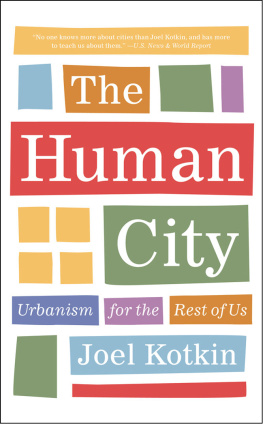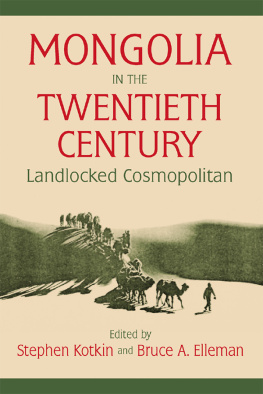Table of Contents
ALSO BY JOEL KOTKIN
California, Inc. (with Paul Grabowicz)
The Valley
The Third Century: Americas Resurgence in the
Asian Era (with Yoriko Kishimoto)
Tribes: How Race, Religion, and Identity Determine
Success in the New Global Economy
The New Geography: How the Digital Revolution
Is Reshaping the American Landscape
The City: A Global History

THE PENGUIN PRESS
Published by the Penguin Group
Penguin Group (USA) Inc., 375 Hudson Street, New York, New York 10014, U.S.A.
Penguin Group (Canada), 90 Eglinton Avenue East, Suite 700, Toronto, Ontario, Canada
M4P 2Y3 (a division of Pearson Penguin Canada Inc.) Penguin Books Ltd, 80 Strand,
London WC2R 0RL, England Penguin Ireland, 25 St. Stephens Green, Dublin 2, Ireland
(a division of Penguin Books Ltd) Penguin Books Australia Ltd, 250 Camberwell Road,
Camberwell, Victoria 3124, Australia (a division of Pearson Australia Group Pty Ltd)
Penguin Books India Pvt Ltd, 11 Community Centre, Panchsheel Park,
New Delhi - 110 017, India Penguin Group (NZ), 67 Apollo Drive, Rosedale,
North Shore 0632, New Zealand (a division of Pearson New Zealand Ltd) Penguin Books
(South Africa) (Pty) Ltd, 24 Sturdee Avenue, Rosebank, Johannesburg 2196, South Africa
Penguin Books Ltd, Registered Offices: 80 Strand, London WC2R 0RL, England
First Published in 2010 by The Penguin Press, a member of Penguin Group (USA) Inc.
Copyright Joel Kotkin, 2010
All rights reserved
LIBRARY OF CONGRESS CATALOGING-IN-PUBLICATION DATA
Kotkin, Joel.
The next hundred million : America in 2050 / Joel Kotkin.
p. cm.
Includes bibliographical references and index.
eISBN : 978-1-101-19570-3
1. Social predictionUnited States. 2. Population forecastingUnited States.
3. Cities and townsUnited StatesGrowthForecasting.
4. United StatesForecasting. I. Title.
HN60. K68 2010
307.7609730112dc22 2009030609
Without limiting the rights under copyright reserved above, no part of this publication may be reproduced, stored in or introduced into a retrieval system, or transmitted, in any form or by any means (electronic, mechanical, photocopying, recording or otherwise), without the prior written permission of both the copyright owner and the above publisher of this book.
The scanning, uploading, and distribution of this book via the Internet or via any other means without the permission of the publisher is illegal and punishable by law. Please purchase only authorized electronic editions and do not participate in or encourage electronic piracy of copyrightable materials. Your support of the authors rights is appreciated.
While the author has made every effort to provide accurate telephone numbers and Internet addresses at the time of publication, neither the publisher nor the author assumes any responsibility for errors, or for changes that occur after publication. Further, publisher does not have any control over and does not assume any responsibility for author or third-party Web sites or their content.
http://us.penguingroup.com
For Ariel and Hannah, and their future
CHAPTER ONE:
FOUR HUNDRED MILLION AMERICANS
This book is inspired by a remarkable fact: in stark contrast to its more rapidly aging rivals in Europe and Asia, Americas population is expected to expand dramatically in coming decades. According to the most conservative estimates, the United States by 2050 will be home to at least four hundred million people, roughly one hundred million more than live here today. But because of Americas unique demographic trajectory among advanced countries, it should emerge by midcentury as the most affluent, culturally rich, and successful nation in human history.
The addition of a hundred million more residents also will place new stresses on the environment, challenging the country to build homes, communities, and businesses that can sustain an expanding and ever-more-diverse society. America will inevitably become a more complex, crowded, and competitive place, highly dependent, as it has been throughout its history, on its peoples innovative and entrepreneurial spirit.
The United States of 2050 will look very different from the country that existed just a decade ago, at the dawn of the new millennium. Between 2000 and 2050 the vast majority of Americas net population growth will be in its racial minorities, particularly Asians and Hispanics, as well as in a growing mixed-race population. By midcentury the United States will be a predominantly white country no longer but rather a staggering amalgam of racial, ethnic, and religious groups, all participants in the construction of a new civilization whose roots lie not in any one country or continent but across the entirety of human cultures and racial types. No other advanced, populous country will enjoy such ethnic diversity.
These demographic changes will affect Americas relations with the rest of the world. The United States likely will remain militarily preeminent, but it may well be wary of its long experience in leading the world through force or through overweening economic or political power. Americas wars of the late 20th and early 21st centuriesin Vietnam, Iraq, and Afghanistanhave shown the limits of superpower status in a world marked by technological diffusion, fierce economic competition, and ever-more-sophisticated unconventional warfare.
Instead the future United States will seek to exercise its influence primarily through technological and cultural innovation and through the dynamism of its diverse society. The election of Barack Obama, the nations first African-American president, displayed the changing nature of the country to the world. In this sense the primacy of America in 2050 will rest, as Thomas Jefferson saw back in 1817, not on conquest, but in principles of compact and equality.
Such long-term optimism may seem out of place in the wake of the great economic recession that began in late 2007. The downturn has devastated the national economy and appears to some Americans to be the prelude to a new dark age. Many critical elements of the American dream, such as home ownership, have slipped away from millions of families, at least for the short term. Confidence in the financial system and capitalism itself has fallen to historic lows, as has belief in the political parties, despite the immense popularity in some quarters of the current president. Huge parts of the countrys industrial base, most notably the automobile industry, have experienced a massive contraction while many other critical concernsfrom health care and education to basic infrastructural needsstill remain to be fully addressed.
Yet this book looks beyond short-term hardship and seeks to illuminate the paths that can lead to a potentially brighter future. Americas robust population growth represents just one reason to believe that the United States will remain ascendant in this new era. With proper dedication to its ancient ideals and an embrace of new technology, the United States can emerge as a land of unprecedented opportunity: a youthful, evolving nation amid an advanced industrial world beset by old age, bitter ethnic conflicts, and erratically functioning economic institutions.
This surge in growth, like previous boom eras, will impose itself on the national landscape and reshape the national geography. Scores of new communities will have to be built to accommodate the next hundred million Americans. This will create a massive demand for new housing, as well as industrial and commercial space. This growth will be variously expressed, from the widespread infilling of once-desolate inner cities, to the creation of new suburban and exurban towns, to the resettling of the American Heartlandthe vast, still sparsely populated regions that constitute the vast majority of the U.S. landmass. In order to accommodate the next hundred million Americans, new environmentally friendly technologies and infrastructure will be required, to reduce commutes by bringing work closer to or even into the home and by finding more energy-efficient means of transportation.













